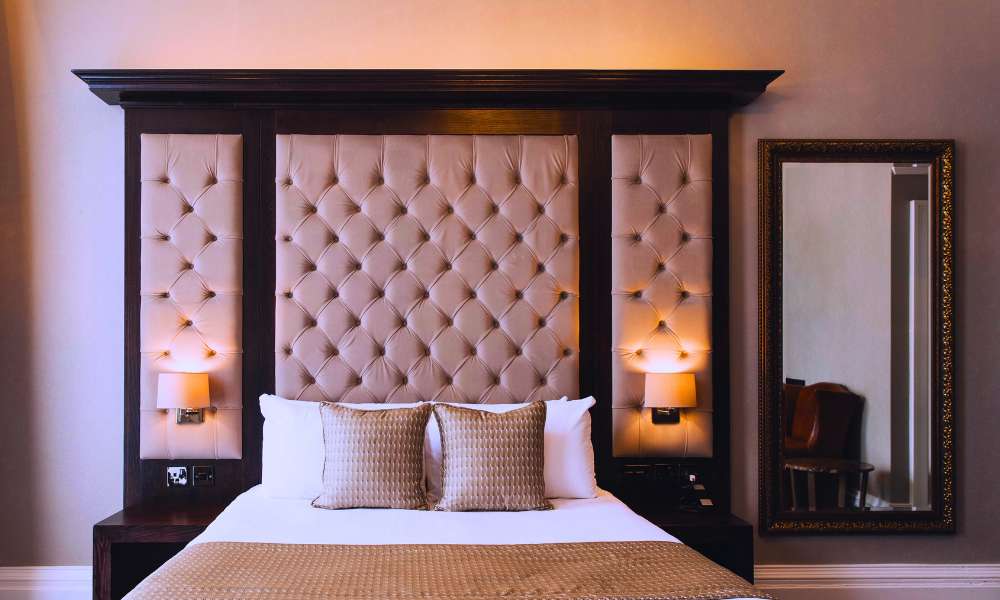Headboards serve both functional And aesthetic purposes in bedroom decor. They provide support And comfort while sitting up in bed, And they also enhance the overall style And design of the room. In this article, We will explore the various ways in which headboards attach to bed frames. We will discuss traditional methods such as bolt-on headboard brackets, As well as more modern options like wall-mounted headboards And freestanding headboards. Whether you’re looking to add A new headboard to your existing bed frame Or seeking guidance on selecting A compatible set, This article will provide you with the essential knowledge to make An informed decision.
Can A Headboard Be Attached To Any Bed Frame?
While many bed frames are designed to accommodate headboards, It’s important to note that not all bed frames are compatible with headboard attachment. The ability to attach A headboard depends on the specific design And features of both the bed frame And the headboard.
Here are A few factors to consider when determining if a headboard can be attached to A bed frame:
- Headboard Mounting Holes
- Universal Headboard Brackets
- Wall-Mounted Headboards
- Freestanding Headboards
Check Your Bed Frame For Brackets
you can easily check your bed frame for brackets by inspecting the headboard area. Here’s what you can do:
- Examine the headboard area: Look at the top end of your bed frame, Specifically the area where the headboard would be attached. Check for any visible brackets, Holes, Or attachment points. These brackets are often located on the vertical bars Or posts at the head of the bed frame.
- Check for pre-drilled holes: If your bed frame is designed to accommodate a headboard, You may find pre-drilled holes Or slots specifically intended for attaching one. These holes are usually evenly spaced And provide a secure mounting point for the headboard.
- Look for removable panels: Some bed frames have removable panels Or caps that can be taken off to reveal hidden brackets Or attachment points. If you notice any removable parts near the headboard area, Try removing them to see if they uncover any mounting options.
- Consult the bed frame manual: If you have the manual or instruction guide that came with your bed frame, Refer to it for information on attaching a headboard. The manual may provide specific instructions Or indicate if the bed frame is compatible with headboard attachment.
Attach The Headboard Based On Type
Here are the steps to attach a headboard based on different types of attachment methods:
Bolt-on Headboard Brackets:

- Place your bed frame in the desired position And ensure it is stable.
- Align the pre-drilled holes on the headboard brackets with the corresponding holes or slots on the bed frame.
- Insert bolts or screws through the brackets And into the bed frame holes.
- Tighten the bolts or screws securely using a screwdriver or wrench, ensuring the headboard is firmly attached to the bed frame.
Universal Headboard Brackets:
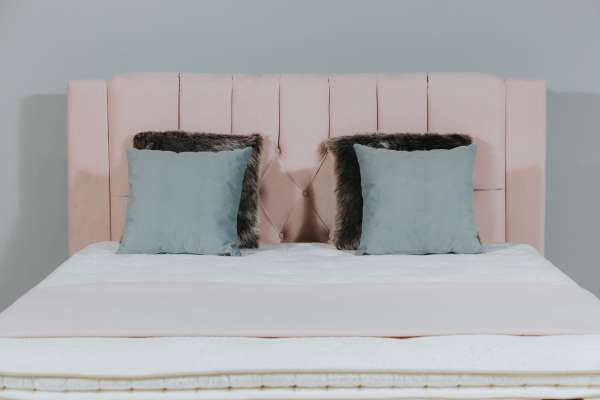
- Position the universal headboard brackets on the bed frame where you want to attach the headboard.
- Mark the location of the bracket holes on the bed frame.
- Drill pilot holes at the marked locations on the bed frame to make it easier to insert the screws.
- Place the brackets back on the bed frame And align the holes with the pilot holes.
- Insert screws through the brackets And into the pilot holes, And then tighten them using a screwdriver or wrench until the brackets are securely fastened.
Wall-Mounted Headboards:

- Decide on the desired height And position for your wall-mounted headboard behind the bed.
- Use a stud finder to locate the wall studs where you want to attach the headboard.
- Mark the positions of the studs on the wall.
- Attach mounting brackets or cleats to the wall at the marked stud positions, ensuring they are level And securely anchored.
- Lift the headboard into position, aligning it with the mounted brackets or cleats.
- Securely fasten the headboard to the brackets or cleats using appropriate screws or bolts.
Freestanding Headboards:
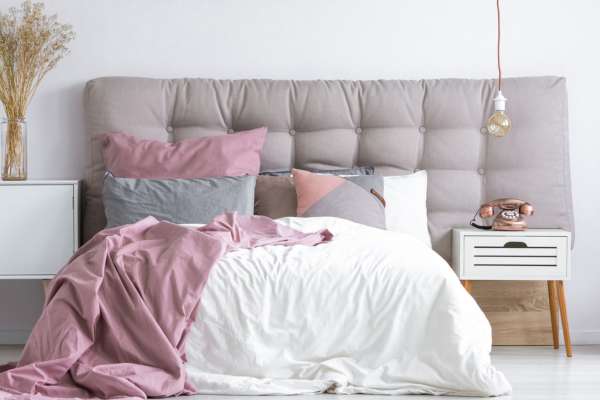
- Place the freestanding headboard behind the bed in the desired position.
- Adjust the headboard so it stands upright And is stable.
- If the headboard has stabilizing legs or feet, ensure they are properly aligned And supporting the weight of the headboard.
- You may also choose to secure the headboard to the wall using wall anchors or brackets for added stability.
Characterization By Headboard Material
When it comes to headboards, the material used plays a significant role in defining their aesthetic appeal, durability, And overall character. Here are some common headboard materials And their associated characteristics:
Wood:
- Classic And timeless: Wood headboards offer a traditional And timeless look that can suit various interior styles.
- Warm And inviting: The natural warmth And texture of wood create a cozy And inviting atmosphere in the bedroom.
- Versatile: Wood headboards come in various finishes, such as oak, walnut, cherry, or painted options, allowing for a wide range of style choices.
- Durable: Depending on the type of wood, these headboards can be sturdy And long-lasting.
Upholstered:
- Luxurious And comfortable: Upholstered headboards are often padded And covered in fabric or leather, providing a plush And comfortable surface for leaning against.
- Elegant And Stylish: The fabric or leather upholstery adds a touch of sophistication And elegance to the bedroom decor.
- Versatility in design: Upholstered headboards offer numerous design options, from simple And minimalistic to tufted or patterned, allowing for customization according to personal style.
- Softens the room: Upholstered headboards can soften the overall look And feel of the bedroom, adding a layer of texture And visual interest.
Metal:
- Sleek And Contemporary: Metal headboards can give a modern And sleek appearance to bedroom decor.
- Sturdy And Durable: Depending on the quality of the metal used, these headboards can be strong And long-lasting.
- Versatility in design: Metal headboards are available in various designs, from simple And minimalist to intricate And decorative, catering to different style preferences.
- Airy And lightweight: Metal headboards can create an open And airy feel in the room, making them a suitable choice for smaller spaces.
Wicker or Rattan:
- Natural And Bohemian: Wicker or rattan headboards evoke a relaxed And bohemian vibe, bringing a touch of nature indoors.
- Textural And unique: The woven texture of wicker or rattan adds visual interest And a unique aesthetic to the bedroom.
- Lightweight And easy to move: These headboards are often lightweight And easy to maneuver, making them convenient if you like to rearrange your furniture frequently.
- Blends well with coastal or tropical themes: Wicker or rattan headboards can seamlessly integrate into coastal or tropical-inspired bedroom designs.
Popular Headboard Installation Options
When it comes to installing headboards, there are several popular options that offer different levels of flexibility, stability, And convenience. Here are some of the commonly used headboard installation options:
Bolt-On Headboard Brackets:
- This is a traditional And secure method of attaching headboards to bed frames.
- The bed frame usually has pre-drilled holes or brackets specifically designed for attaching the headboard.
- Headboard brackets are aligned with the corresponding holes on the bed frame, And bolts or screws are used to secure them in place.
- This method provides a stable And fixed attachment, ensuring the headboard remains securely in position.
Universal Headboard Brackets:
- Universal headboard brackets offer a versatile solution for attaching headboards to bed frames that don’t have built-in attachment points.
- These brackets are adjustable And can be attached to various bed frame designs.
- They typically feature holes or slots for securing the headboard, allowing for customization based on the headboard And bed frame dimensions.
- Universal brackets provide flexibility in positioning the headboard And offer a secure attachment when properly installed.
Wall-Mounted Headboards:
- Wall-mounted headboards attach directly to the wall behind the bed, offering a unique And stylish installation option.
- This method doesn’t rely on the bed frame for support, providing more freedom in headboard selection.
- Mounting brackets or cleats are attached to the wall, And the headboard is secured to these brackets.
- Wall-mounted headboards offer flexibility in height adjustment And can be easily moved or replaced without affecting the bed frame.
Freestanding Headboards:
- Freestanding headboards are not attached to the bed frame or the wall but stand independently behind the bed.
- These headboards are designed with stabilizing legs or feet that support their weight And keep them in place.
- Freestanding headboards offer convenience as they can be easily moved or adjusted without any installation or attachment required.
- This option allows for more flexibility in changing the headboard’s position or using it with different bed frames.
Choose A Headboard
Selecting a headboard ultimately depends on your personal style preferences, bedroom decor, And the specific requirements of your bed frame. However, I can provide you with a few popular headboard options to consider:
Upholstered Wingback Headboard:
- This type of headboard features a padded upholstered surface with tall, curved sides (wings) that give it a distinct And luxurious look.
- Upholstered wingback headboards often offer a comfortable surface for leaning against while adding a touch of elegance to the bedroom.
- They come in a variety of fabric options, colors, And patterns, allowing you to customize the headboard to match your bedroom decor.
Wooden Slat Headboard:
- A wooden slat headboard offers a classic And versatile design that can complement various bedroom styles.
- These headboards make of wood slats or panels arranged horizontally or vertically, creating a clean And modern look.
- Wooden slat headboards are available in different wood finishes, allowing you to choose the one that best suits your taste And existing furniture.
Metal Scroll Headboard:
- Metal scroll headboards feature intricate metalwork with decorative scroll patterns, adding an elegant And vintage touch to the bedroom.
- These headboards often have a combination of metal bars, curves, And intricate details that create a visually appealing focal point.
- Metal scroll headboards are available in different finishes, such as iron, brass, or bronze, allowing you to select the one that complements your bedroom decor.
Wicker or Rattan Headboard:
- Wicker or rattan headboards are ideal for creating a relaxed And natural atmosphere in the bedroom.
- These headboards make from woven natural fibers, adding texture And a touch of bohemian charm to the space.
- Wicker or rattan headboards are often lightweight And offer a casual yet stylish option for coastal or tropical-inspired bedroom designs.
Attach The Headboard Based On Type
1. Wooden Headboard

- Position the wooden headboard against the wall at the desired height.
- Use a level to ensure it is straight And aligned.
- Mark the mounting hole locations on the wall using a pencil.
- Drill pilot holes at the marked locations.
- Insert wall anchors into the pilot holes if necessary.
- Align the mounting holes on the headboard with the pilot holes or wall anchors.
- Secure the headboard to the wall using screws, ensuring it firmly attached.
2. Metal Headboard

- Position the metal headboard against the wall or bed frame, depending on the design.
- Use a level to ensure it is straight And aligned.
- If attaching to a bed frame, follow the manufacturer’s instructions for installation.
- If attaching directly to the wall, mark the mounting hole locations on the wall using a pencil.
- Drill pilot holes at the marked locations.
- Insert wall anchors into the pilot holes if necessary.
- Align the mounting holes on the headboard with the pilot holes or wall anchors.
- Secure the headboard to the wall or bed frame using screws, ensuring it securely fastened.
3. Upholstered Headboard
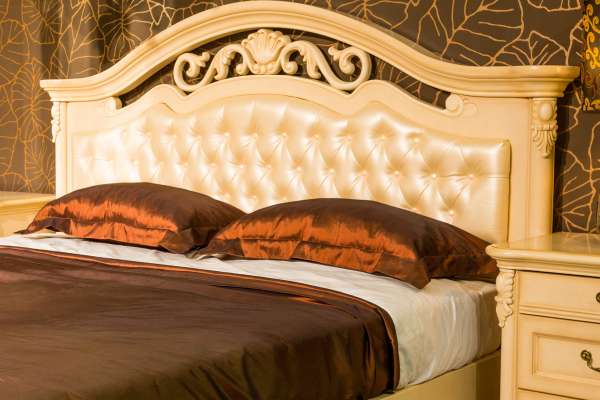
- Position the upholstered headboard against the wall or bed frame.
- Use a level to ensure it is straight and aligned.
- If attaching to a bed frame, follow the manufacturer’s instructions for installation.
- If attaching directly to the wall, mark the mounting hole locations on the wall using a pencil.
- Drill pilot holes at the marked locations.
- Insert wall anchors into the pilot holes if necessary.
- Align the mounting holes on the headboard with the pilot holes or wall anchors.
- Secure the headboard to the wall or bed frame using screws, ensuring it securely fastened.
4. Free-Standing Headboard

- Place the free-standing headboard behind the bed in the desired position.
- Adjust the headboard so it stands upright and is stable.
- If the headboard stabilizes legs or feet, ensure they properly aligned and supporting the weight of the headboard.
- You may also choose to secure the headboard to the wall using wall anchors or brackets for added stability.
5. Bed Frame Mounted Headboard

- Follow the manufacturer’s instructions specific to your bed frame and headboard combination.
- Typically, bed frame-mounted headboards involve aligning the pre-drilled holes or brackets on the headboard with the corresponding holes or brackets on the bed frame.
- Insert bolts or screws through the brackets and tighten them securely to attach the headboard to the bed frame.
6. Wall-Mounted Headboard
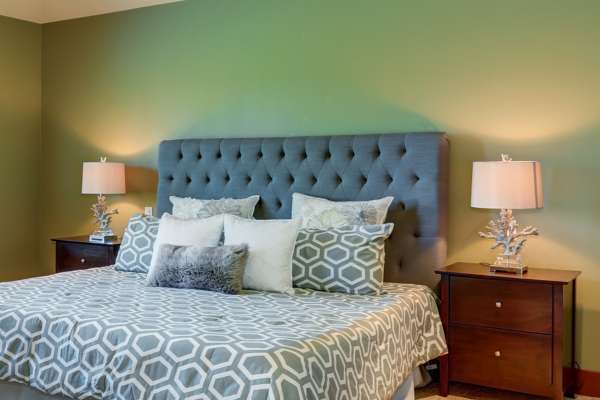
- Choose the desired position for the wall-mounted headboard.
- Measure And mark the height And width of the headboard on the wall.
- Locate wall studs using a stud finder And mark their positions.
- Install mounting brackets on the wall at the marked locations, aligning them with the stud positions.
- Attach the corresponding brackets Or mounting hardware to the back of the headboard.
- Position the headboard against the wall, aligning the brackets on the headboard with the installed brackets on the wall.
- Insert screws Or bolts through the brackets And into the wall Or wall anchors.
- Tighten the screws Or bolts securely to ensure the headboard firmly attached to the wall.
7. Characterization By Headboard Design

- The installation process for headboards with unique designs will vary depending on the specific design And materials used.
- Follow the manufacturer’s instructions for your particular headboard design.
- Generally, you will need to position the headboard against the wall or bed frame, ensuring it is straight And aligned.
- Mark the mounting hole locations on the wall or bed frame using a pencil.
- Drill pilot holes at the marked locations.
- Insert wall anchors into the pilot holes if necessary.
- Align the mounting holes on the headboard with the pilot holes or wall anchors.
- Secure the headboard to the wall or bed frame using screws or bolts, following the manufacturer’s guidelines for proper attachment.
8. Traditional Headboard

- The installation process for a traditional headboard will depend on the specific type And materials used.
- Follow the general instructions mentioned earlier for wooden, metal, or upholstered headboards, depending on the material of your traditional headboard.
- Ensure proper alignment And secure attachment based on the specific design And mounting options provided by the manufacturer.
9. Modern Headboard

- The installation process for a modern headboard will depend on the specific design And materials used.
- Follow the general instructions mentioned earlier for the corresponding headboard material, such as wooden, metal, or upholstered headboards.
- Pay attention to any specific mounting mechanisms or additional hardware provided by the manufacturer for attaching the modern headboard.
10. Slat Headboard
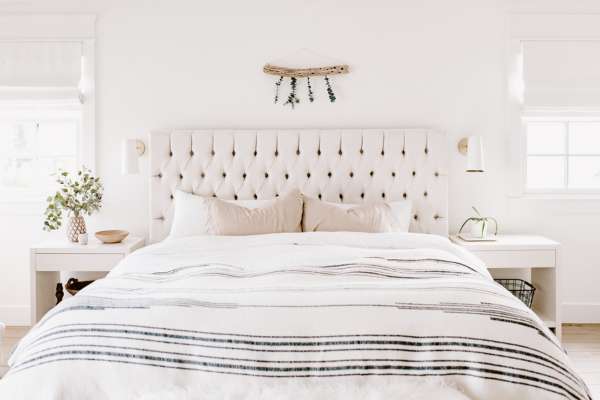
- Slat headboards typically consist of a series of horizontal or vertical wooden slats.
- Position the slatted headboard against the wall or bed frame, ensuring it is straight And aligned.
- If attaching to a bed frame, follow the manufacturer’s instructions for installation.
- If attaching directly to the wall, mark the mounting hole locations on the wall using a pencil.
- Drill pilot holes at the marked locations.
- Insert wall anchors into the pilot holes if necessary.
- Align the mounting holes on the headboard with the pilot holes or wall anchors.
- Secure the headboard to the wall or bed frame using screws, ensuring it is securely fastened.
Characterization By Headboard Size
Headboards come in various sizes to accommodate different bed sizes and preferences. Here are the common headboard sizes based on bed sizes:
Twin/Single Headboard:
- Suitable for twin or single beds.
- Typically measures around 39 inches wide.
Full/Double Headboard:
- Designed for full or double beds.
- Usually measures around 54 inches wide.
- Queen Headboard:
- Designed for queen-size beds.
- Typically measures around 60 inches wide.
King Headboard:
- Designed for king-size beds.
- Typically measures around 76 inches wide.
California King Headboard:
- Designed for California king-size beds.
- Usually measures around 72 inches wide.
It’s important to note that headboard sizes may vary depending on the specific design and manufacturer. It’s recommended to check the measurements provided by the manufacturer before purchasing a headboard to ensure it will properly fit your bed size.
The Final Touches
In conclusion, headboards attach to bed frames using various methods depending on the type of headboard And bed frame. The attachment method ensures stability And enhances the overall aesthetic of the bed. It’s important to refer to the specific instructions provided by the manufacturer for your headboard And bed frame to ensure proper attachment. Following the recommended installation process ensures the stability, safety, And longevity of the headboard attachment. By choosing the appropriate attachment method And ensuring a secure fit, you can enjoy a well-crafted headboard that adds style, comfort, And personality to your bedroom.
